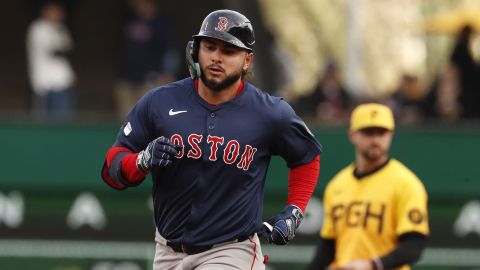Pull up a chair and brace yourself for the silver lining of silver linings. All one asks is you don’t shoot the messenger and you take this for what it is: an attempt to extract some positive from a total mess.
The Boston Red Sox entered Wednesday with the worst record in the American League, which, as The Boston Globe’s Alex Speier pointed out earlier this week, might not necessarily be a bad thing.
OK, it’s a bad thing — a very bad thing — and the Red Sox surely never envisioned this when they spent almost $200 million on Hanley Ramirez and Pablo Sandoval over the offseason. This team was supposed to go places. (Again, don’t shoot.) But, as Speier eloquently highlighted, there’s some benefit to having the worst record in the AL as opposed to, say, the second-worst or the third-worst record.
You see, waiver order is determined by team record. The worst teams in the American League and National League have top priority when it comes to claiming players exposed to waivers, with teams in the same league as a player put on waivers having priority over teams in the opposite league.
In other words, the worst team in the AL receives the first crack at any players exposed to waivers by AL teams. And the Red Sox, as of Wednesday afternoon, were the team in that potentially favorable, yet unflattering, position.
The Red Sox also own a tiebreaker over the Oakland Athletics — the second-worst team in the AL, as of Wednesday afternoon — by virtue of finishing with a worse record than the A’s in 2014, meaning Boston would be awarded the waiver claim in any scenario in which both teams claimed the same player.
Does this really mean a whole lot? Probably not. Waiver claims rarely precipitate significant August trades, although it’s possible, as most players placed on revocable waivers — there are quite a few — are pulled back by their respective teams. But, as Speier notes, virtually every player gets placed on revocable waivers in August — and subsequently pulled back — so there’s room for due diligence.
That’s tantalizing for the Red Sox, who used the July 31 Major League Baseball non-waiver trade deadline as an opportunity to gauge the marketplace and to gather information for the offseason. Boston can do additional homework in August that some other teams can’t by virtue of their standing in the waiver process.
Speier used A’s ace Sonny Gray as an example. Let’s say Oakland places Gray on revocable waivers this month to gauge interest, or whatever. The Red Sox, who would love to acquire a pitcher like Gray, can put in a waiver claim knowing they’ll have the first shot at the 25-year-old because they have the worst record in the AL.
The A’s obviously would pull Gray back off waivers, so it’s not like the Red Sox are positioned to land such a player in August because of their crappy record. But Boston would have two days to chat with Oakland, perhaps stimulating discussion that leads to bigger things down the road.
This doesn’t just apply to the A’s and Gray, of course. The Red Sox could go through a similar feeling-out process with the Cleveland Indians regarding Carlos Carrasco or the Chicago White Sox regarding Chris Sale — with any AL team regarding whoever.
Now, just as this exercise wasn’t meant to slap lipstick on a pig, it also wasn’t meant to make a mountain out of a molehill. There’s a chance, maybe a good one, that nothing of substance evolves from such talks.
However, the Sox can, in theory, use their poor place in the standings to their advantage as they continue the information-gathering process they began well before the July 31 non-waiver trade deadline. And that’s notable, if nothing else, for a team with big holes to fill this winter.
Thumbnail photo via Greg M. Cooper/USA TODAY Sports Images




